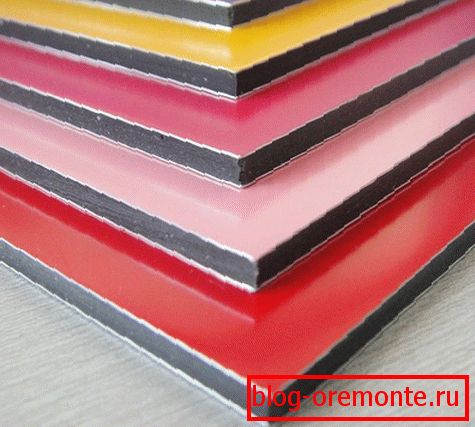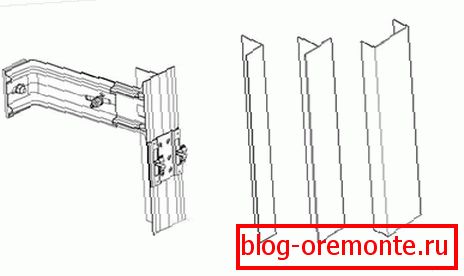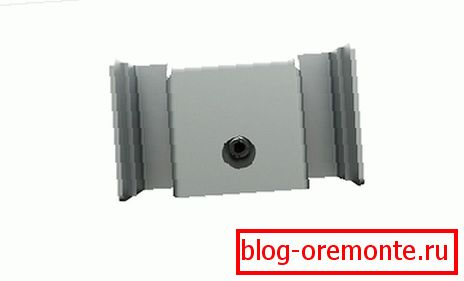Facing the facade with composite panels
Among the materials for exterior cladding of buildings, new, improved versions regularly appear. Composite panels are one of the modern ways to create a unique architectural style of a new building or to improve the appearance of a dilapidated facade. Resistance to different temperatures allows the material to be used in cold and hot regions.. Facing the facade with composite panels will create a favorable microclimate inside the building and reduce heating costs in the winter and air conditioning in the summer.
Special features

Composite finishing involves combining materials with different characteristics into one. For finishing, panels from two aluminum sheets connected by a polymeric core are used. They have a more complex structure. Aluminum composite panels AKP have:
- removable protective film;
- colorless layer;
- polyester lacquer paint, high-gloss polyester, UVD-resistant PVDF, lamination with wood imitation or spraying of metal powder;
- primed aluminum sheet;
- adhesive layer;
- polymer base;
- An outer coating that protects the back side from corrosion, usually an anodized film or primer.

The ACP is a rigid material, the polymer interior allows you to maintain a specified distance between the aluminum sheets, which ensure the strength of the structure. The top layer is responsible for the tensile force, and the bottom provides compression. The thickness of the metal is 2–6 mm, the width of the panel is from 1 to 1.5 m, the standard length is 3–4 m, if necessary, 6 m models are supplied.
Among the core fillers, expanded polyethylene with non-combustible additives is distributed. More expensive panels have mineral filler, and the lightest and strongest are filled with aluminum honeycombs. The space between the sheets is overlapped by thin transverse plates forming the cells. The metal composite is inferior to the panels with the polymer on thermal insulation characteristics. By design, all composite materials are the same, depending on the manufacturer varies the internal content.
Benefits of AKP

Facing the facade with aluminum panels allows in a short time to give it an attractive look and has a number of positive characteristics:
- The ventilated facade design protects the walls from dampness and wind.
- Light panels slightly weight the building.
- The outer coating is resistant to fading, chemical and weathering. On a smooth surface, dirt and dust almost does not linger, and it is easy to clean.
- AKP create additional barter from street noise.
- The structure of the structure meets the standards of fire safety.
- Composite panels reduce heat loss and absorb vibration. They do not accumulate electricity and are environmentally friendly.
- The ability to replace the damaged parts at any time of the year without prior preparation and complex processes.
- A wide range of AKP provides a choice of many colors of outdoor coating.
- When heated, the material does not expand and for a long time resists external influences.

The substantial area of each panel allows you to quickly sheathe the facade. Strict geometrical parameters eliminate the need to customize adjacent parts and align joints.
Minuses
The outer coating of the panels is subject to mechanical stress, the paint layer is easily damaged. Care must be taken during installation. The disadvantage of preventing the spread of the material is its high cost. In addition, aluminum composite panels are in the same price segment with high-end facade cladding.
Preparation for installation
For high-quality cladding, you need to buy panels, profiles and fasteners from the same manufacturer. These parts are ideally suited to each other’s dimensions, and third-party fasteners may not match the size of the mounting holes. This will make the ventilated facade unreliable and cause deformation of the panels.

Before mounting the ventilated facade, the wall is marked under the frame. The location of the vertical profile is plotted first, then the fixing areas of the brackets are marked. The purpose of this element is to control the plane of the composite panels. Its design has a retractable insert, with which the adjustment is made to the required level. The brackets are mounted 45–50 cm apart. The horizontal distance depends on the width of the cladding panel. Anchoring bolts or dowels are required for mounting.
Types of carrier profile
Three types of support profile are used under the ventilated facade: L-shaped, U-shaped and T-shaped. Their names are chosen because of the form corresponding to the appearance of the letters.
Facade insulation
After fixing all the brackets, the building is insulated. Mineral wool or polystyrene is used as an insulating material for cold. Laying plates made before mounting the support profile. In the places corresponding to the location of the brackets, an incision is made, and the insulation is put on the protruding part. Fixing mineral wool is carried out with dowels, fungi, and the foam is glued to the walls. Holes are drilled for fasteners so that the wool is not wound on the tool, a metal tube is inserted, slightly larger than the diameter of the drill.

Covering the entire area with insulating plates, proceed to the installation of a wind barrier from a special membrane. It will protect the insulation from moisture and increase the tightness of the cladding.
Note! It is better to fix the insulation mats after placing the protective film, then one wind-plug and wind-resistant insulation material is fixed with one dowel.
Profile mounting
A guide profile is attached to the level-adjusted bracket bracket. Attaching it to the part, drill the holes and fix the profile with two riveted hardware, using a special tool. This mount provides high structural strength. If it is necessary to connect the fastening profile, a tire is used in which two holes are drilled in each joined part and rivets are inserted.
Note! Compliance with a single plane of the frame is an important point during installation. To check the level between the extreme guides, set on a vertical level, stretch the nylon thread. They are guided by them when setting the amount of bracket bracket removal.
Installation

Installation of front cassettes is performed on the spacer slide, included in the kit fixture. The part is inserted into the guide profile, and screwed to it with a self-tapping screw or fixed with a rivet. At its edges are fixed brackets to which the panel is attached, in the same way that the sled to the profile. For each composite cassette, 4 slides are required: 2 at the top and 2 at the bottom. In addition, the panel is fixed on the profile. It is necessary to leave a gap of up to 10 mm between adjacent aluminum cassettes.

Note! If the composite has a pattern with imitation of wood or stone, then it is necessary to take into account the coincidence of details.
Composite panels are modern, practical and attractive material. Its installation is carried out at any time of the year and can be carried out by a hired construction organization or on its own.
See also:
Facade siding do it yourself
How to sheathe a house blockhouse
How to sheathe the facade professional sheet
Facade decoration
Facade decoration sandwich panels
Facade decoration with granite
Video
In the following video you can learn how to install Kraspan composite panels: